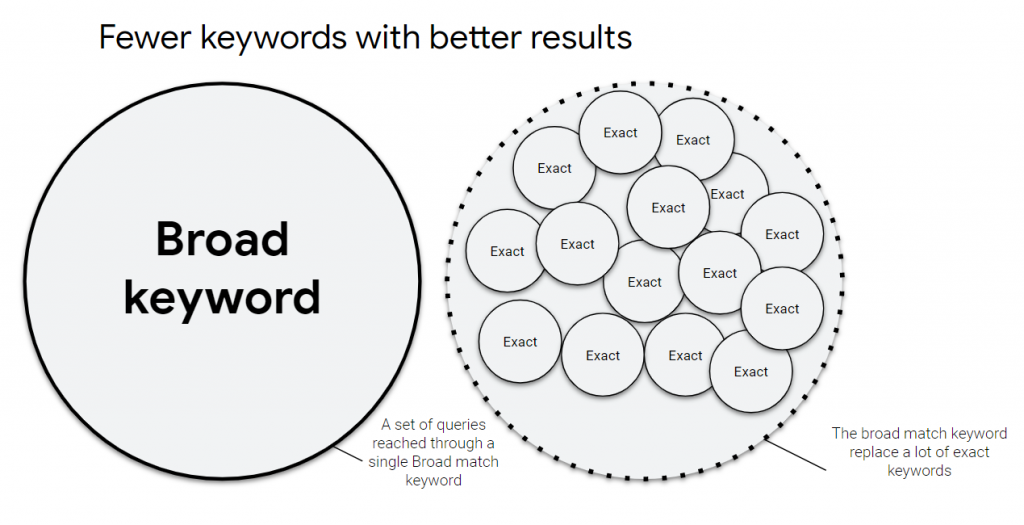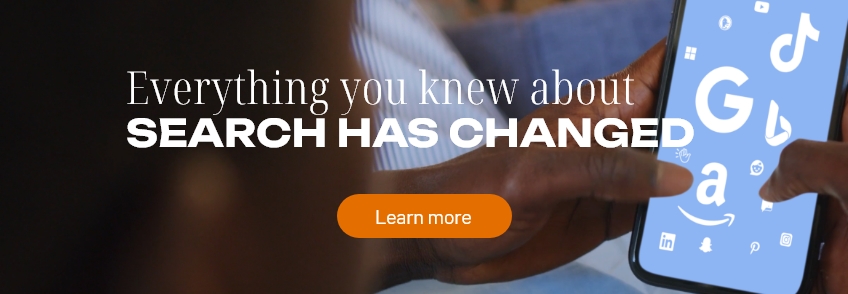In This Article
Over the last few years search advertising has changed, in part due to the progress of Artificial Intelligence. From historical data collected, machines can predict trends and make automated decisions without any human intervention. Google has incorporated more and more machine learning into its products and has made huge progress in terms of automated bidding and recommendations. Smart Bidding uses a combination of signals to set the best bids for each auction. We are moving away from manual management for many campaigns, and instead towards a more automated and simplified structure.
Google continuously pushes marketers to rethink the paid search account structures for more efficiency and to prepare for the future. It reduced the campaign management time, and the margin for errors. These are the latest Google best practices; 4 co-dependent principles to follow for success.
1. From granular structure to consolidated.
There are an infinite number of ways to segment campaigns including keywords, audience, device, intent, etc. However, this segmentation is no longer necessary.
Google recommends having simplified account structures for better performance through machine learning. A consolidated structure contains less campaigns with fewer, but ultimately larger ad groups. Each campaign is based on one specific objective, and leads to a specific URL (both relative to the ad group). All the ad groups should have at least 5,000 impressions per month.
In the example below, a company sells home entertainment systems and electrical goods. There are 4 generic paid search campaigns, grouped by type of product.
| Campaign 1 | Campaign 2 | Campaign 3 | Campaign 4 |
| Computers | Washing Machines | Refrigerators | Televisions |
Computers are the most significant products as they drive most of the sales with a high profit margin. The new recommended structure could result in having only 2 campaigns: Campaign 1 contains only computer terms, and all other products are in Campaign 2. The number of ad groups varies, depending on different factors.
| Campaign 1 – ROAS = 700 | Campaign 2 – ROAS = 900 |
| Computers | Washing Machines Refrigerators Televisions |
2. Fewer and smarter keywords.
When using the old method of manual bidding, keywords under different match types were used. Each of them could have for example; a specific bid, landing page or ad copy, and perform differently. With Smart Bidding, there is no reason to spread out data across different keyword matches but rather to maximise the volume of data by expanding to broader match types. A big advantage of this is that it is much less time-consuming, allowing analysts to focus on the insight and planning rather than manual management, and it can cover new queries.

3. Empower your campaigns with DSA.
Dynamic Search Ads is a great automated tool to capture incremental traffic, especially from long tail or low volume search queries. Google generates personalised ads based on the landing page for the search queries which it believes are relevant. Google has previously mentioned that each campaign should have an additional ad group for DSA which would work better alongside the standard ones, rather than a separate campaign on its own. The DSA ad group could be set up by using different dynamic ad target conditions, such as URL contains, categories, and so on. It should only target incremental traffic so there is no need to negate the keywords from the standard ad group in the DSA one.

4. Use RSA and dynamic features.
Finally, use all the advanced automated features available to have highly specific ad copy based on the user’s search, and bring your account structure to the next level. It is still important to show highly tailored ads to users which is possible with dynamic features such as Responsive Search Ads, dynamic keyword insertion, if functions or ad customisers.
How to make Responsive Search Ads work for you
Write as many assets as possible (up to 15 headlines and 4 descriptions) to maximise the number of opportunities to create relevant and unique ads, which match user queries. Google will test different combinations and show the best ads for each search query from past learnings. Here’s a number of other things you can do with Responsive Search Ads:
- Dynamically personalise the ads without segmenting traffic.
- Add keywords with Dynamic Keywords Insertion, a piece of code incorporated in the ads to match the user’s search queries.
- Automatically tailor ads and show different variations depending on the device, date, time etc. by using Ad Customisers.
Expanded text ads can be personalised with Dynamic Keywords Insertion and IF functions. For example, adding IF functions targeting audiences can show a different ad to previous visitors, instead of having a specific campaign targeting only those previous visitors.
To conclude…
The key to success in paid search is having a consolidated account. This includes fewer hybrid campaigns with larger ad groups volume and Dynamic Search Ads; but also using broadened keywords and advanced automated features. It is also required to follow all of the standard best practices (e.g. number of ads & ad extensions, attribution model, not limited by budget, etc.) and apply Google automated recommendations, only if it is relevant.
There seems to be lots of advantages, but these are Google’s latest best practices. The account simplification needs to be planned with support and be set up progressively in the best way to avoid negatively impacting performance during the transition. Drastic changes are always risky, and it could be necessary to go through some specific steps e.g. creating some portfolio bidding strategies and adding some shared budgets. While automation limits control and visibility, we still need to follow Google’s best practices. Over time, you should monitor what works and what can be improved.

If you’d like to learn more about how Found can help transition your PPC account into a much more automated model, then get in touch with a member of the team today.


